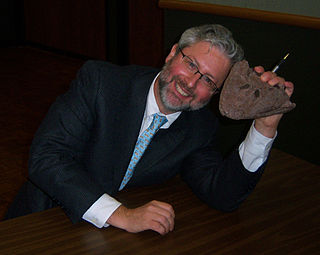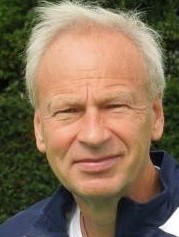Related Research Articles

Evolutionary linguistics or Darwinian linguistics is a sociobiological approach to the study of language. Evolutionary linguists consider linguistics as a subfield of sociobiology and evolutionary psychology. The approach is also closely linked with evolutionary anthropology, cognitive linguistics and biolinguistics. Studying languages as the products of nature, it is interested in the biological origin and development of language. Evolutionary linguistics is contrasted with humanistic approaches, especially structural linguistics.

Evolutionary psychology is a theoretical approach in psychology that examines cognition and behavior from a modern evolutionary perspective. It seeks to identify human psychological adaptations with regards to the ancestral problems they evolved to solve. In this framework, psychological traits and mechanisms are either functional products of natural and sexual selection or non-adaptive by-products of other adaptive traits.

The Westermarck effect, also known as reverse sexual imprinting, is a psychological hypothesis that states that people tend not to be attracted to peers with whom they lived like siblings before age six. This hypothesis was first proposed by Finnish anthropologist Edvard Westermarck in his book The History of Human Marriage (1891) as one explanation for the incest taboo.

Herpetology is the branch of zoology concerned with the study of amphibians and reptiles. Birds, which are cladistically included within Reptilia, are traditionally excluded here; the scientific study of birds is the subject of ornithology.
The biophilia hypothesis suggests that humans possess an innate tendency to seek connections with nature and other forms of life. Edward O. Wilson introduced and popularized the hypothesis in his book, Biophilia (1984). He defines biophilia as "the urge to affiliate with other forms of life".
Margo Wilson (1942–2009) was a Canadian evolutionary psychologist. She was a professor of psychology at McMaster University in Hamilton, Ontario, Canada, noted for her pioneering work in the field of evolutionary psychology and her contributions to the study of violence.
In biology, gonochorism is a sexual system where there are only two sexes and each individual organism is either male or female. The term gonochorism is usually applied in animal species, the vast majority of which are gonochoric.
Dioecy is a characteristic of a species, meaning that it has distinct individual organisms (unisexual) that produce male or female gametes, either directly or indirectly. Dioecious reproduction is biparental reproduction. Dioecy has costs, since only about half the population directly produces offspring. It is one method for excluding self-fertilization and promoting allogamy (outcrossing), and thus tends to reduce the expression of recessive deleterious mutations present in a population. Plants have several other methods of preventing self-fertilization including, for example, dichogamy, herkogamy, and self-incompatibility.

Male is the sex of an organism that produces the gamete known as sperm, which fuses with the larger female gamete, or ovum, in the process of fertilization.
In science and philosophy, a just-so story is an untestable narrative explanation for a cultural practice, a biological trait, or behavior of humans or other animals. The pejorative nature of the expression is an implicit criticism that reminds the listener of the essentially fictional and unprovable nature of such an explanation. Such tales are common in folklore genres like mythology. A less pejorative term is a pourquoi story, which has been used to describe usually more mythological or otherwise traditional examples of this genre, aimed at children.
Evolutionary musicology is a subfield of biomusicology that grounds the cognitive mechanisms of music appreciation and music creation in evolutionary theory. It covers vocal communication in other animals, theories of the evolution of human music, and holocultural universals in musical ability and processing.

The pygmy three-toed sloth, also known as the monk sloth or dwarf sloth, is a species of sloth in the family Bradypodidae. The species is [endemic to Isla Escudo de Veraguas, a small island off the Caribbean coast of Panama. The species was first described by Robert P. Anderson of the University of Kansas and Charles O. Handley Jr., of the Smithsonian Institution in 2001. The pygmy three-toed sloth is significantly smaller than the other three members of its genus, but otherwise resembles the brown-throated three-toed sloth. According to Anderson and Handley Jr., the head-and-body length is between 48 and 53 centimetres, and the body mass ranges from 2.5 to 3.5 kg.
Evolutionary psychology seeks to identify and understand human psychological traits that have evolved in much the same way as biological traits, through adaptation to environmental cues. Furthermore, it tends toward viewing the vast majority of psychological traits, certainly the most important ones, as the result of past adaptions, which has generated significant controversy and criticism from competing fields. These criticisms include disputes about the testability of evolutionary hypotheses, cognitive assumptions such as massive modularity, vagueness stemming from assumptions about the environment that leads to evolutionary adaptation, the importance of non-genetic and non-adaptive explanations, as well as political and ethical issues in the field itself.

Neil Shubin is an American paleontologist, evolutionary biologist and popular science writer. He is the Robert R. Bensley Professor of Organismal Biology and Anatomy, Associate Dean of Organismal Biology and Anatomy and Professor on the Committee of Evolutionary Biology at the University of Chicago along with being the Provost of the Field Museum of Natural History. He is best known for his co-discovery of Tiktaalik roseae with Ted Daeschler and Farish Jenkins.

In reproductive biology, a hermaphrodite is an organism that has both kinds of reproductive organs and can produce both gametes associated with male and female sexes.
The balance of nature, also known as ecological balance, is a theory that proposes that ecological systems are usually in a stable equilibrium or homeostasis, which is to say that a small change will be corrected by some negative feedback that will bring the parameter back to its original "point of balance" with the rest of the system. The balance is sometimes depicted as easily disturbed and delicate, while other times it is inversely portrayed as powerful enough to correct any imbalances by itself. The concept has been described as "normative", as well as teleological, as it makes a claim about how nature should be: nature is balanced because "it is supposed to be balanced".

The Evolution of Desire: Strategies of Human Mating is a 1994 book by evolutionary psychology professor David Buss. It is the first book to present a unified theory of human mating behaviour "based not on romantic notions... but on current scientific evidence." In the largest study of human mating at the time, 10,047 people were surveyed in 37 cultures across six continents and five islands. Buss expands on Donald Symons' The Evolution of Human Sexuality (1979) by examining all the actions that occur before and after sexual activity: strategies of mate competition, mate attraction, mate selection, mate retention, mate poaching, sexual conflict, mate ejection, and remating over a lifespan.

Dieter Gilberto Hillert is a German-American biolinguist and cognitive scientist. His research focuses on the human language faculty as a cognitive and neurological system. He is known for work on the neurobiology of language, real-time sentence processing, and language evolution. He advocates comparative evolutionary studies of cognition, argues against tabula rasa models, and favors computational theories of mind.

Monoecy is a sexual system in seed plants where separate male and female cones or flowers are present on the same plant. It is a monomorphic sexual system alongside gynomonoecy, andromonoecy and trimonoecy.
A sexual system is a pattern of sex allocation or a distribution of male and female function across organisms in a species. Terms like reproductive system and mating system have also been used as synonyms.
References
- ↑ "Hagen, Edward H., 1962-". Library of Congress Name Authority File. Retrieved 2020-05-12.
- ↑ "Edward H. Hagen". Washington State University Vancouver. Retrieved 2020-05-12.
- ↑ Syme, Kristen (2018). "Edward Hagen". Encyclopedia of Evolutionary Psychological Science. Cham: Springer International Publishing. pp. 1–4. doi:10.1007/978-3-319-16999-6_201-1. ISBN 978-3-319-16999-6.
- ↑ Martin, Wednesday (2009-05-04). Stepmonster: A New Look at Why Real Stepmothers Think, Feel, and Act the Way We Do. Houghton Mifflin Harcourt. p. 203. ISBN 978-0-547-39431-2.
- ↑ Check Hayden, Erika (2012-04-26). "Hunt for genetic link to pygmy height yields clue". Nature: nature.2012.10517. doi: 10.1038/nature.2012.10517 . ISSN 0028-0836. S2CID 211729962.
- ↑ Doucleff, Michaeleen (2015-06-23). "Pot For Parasites? Pygmy Men Smoke Out Worms". NPR. Retrieved 2020-05-12.